|
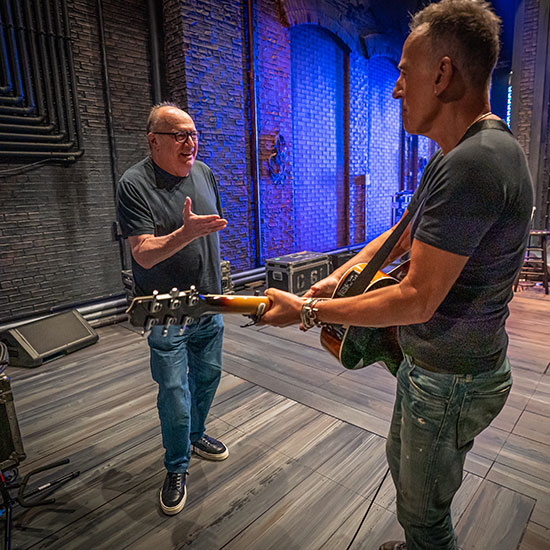
June 2021, St. James Theatre - photograph by Rob DeMartin
With Bruce Springsteen's new Broadway residency underway last week, manager and Springsteen on Broadway Producer Jon Landau spoke with Backstreets about numerous aspects of remounting the show. In describing how the 2021 production has changed from the 2017/18 run, he suggests that the performer is approaching the performance differently this time, for one thing. "The original version had a formality to it," Landau tells Backstreets Editor Chris Phillips, noting a shift in Springsteen's onstage persona detectable from the very beginning of the 2021 show. "I think it's a little more directly just Bruce."
Following the quick decision in late May to revive Springsteen on Broadway, the process of readying the show on short notice in a new theater, the St. James, was far less complicated than one might imagine, as Landau describes it. Of course, it helps to have an artist firing on all cylinders. "The way he sings, the way he speaks, the way he put this together," Landau says of Springsteen's latest effort, "the man is at the top of his game."

Chris Phillips: Congratulations on the return engagement, your continuing run as Broadway producer — just as you've planned it for years, right?
Jon Landau: If you had asked me six weeks ago if we'd be doing this, I would have said no! It's a true surprise.
CP: You're a couple of shows into the run now, and the reviews are stellar. You told Variety you were "thrilled" after opening night, and still on a high. Did you have the same experience after night two? Did anything strike you in a different way?
JL: I watched both of those shows so far, from beginning to end, sitting in the audience, and both nights were fabulous. So, as we speak, I can report that Bruce is thrilled with everything he has done so far.
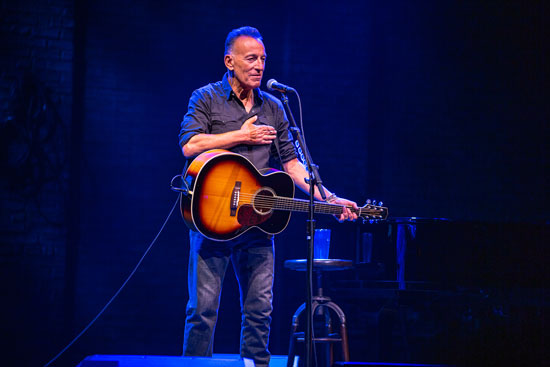
June 2021, St. James Theatre - photograph by Rob DeMartin
We didn't expect the scale of coverage because we were reopening an existing show, not offering something brand new. But the media chose to treat it as something worthy of significant attention, and so we have wound up with some of our best press reaction ever —including two great front-page pieces in the New York Times, a front-page review in the Washington Post, a great article in USA Today, even something terrific in the New York Post, and so much more.
CP: With remarkable headlines, too — basically, "Bruce Springsteen Reopens Broadway!"
JL: That news angle did generate even more interest than I anticipated. When you combine the return of Springsteen on Broadway with the reopening of Broadway, it's a one-plus-one-equals-three situation.
CP: It came together so quickly; can you tell me how it went from thought to reality?
JL: Jordan Roth is the head of the theater group Jujamcyn; the Walter Kerr is his theater. Jordan's a terrific guy, and he called me three or four months ago with this idea for Bruce to reprise the show and reopen Broadway. Besides running his theaters, Jordan loves the theater and is a very involved citizen of Broadway. So he made that call to me a couple of times, and when he called at the end of May, I said, "Let me take it up with Bruce."
Bruce said, "Sounds good." So, the day passes, and then I get a text at one o'clock in the morning: "Let's do it!"
CP: I'm thinking of different factors that might have gone into that decision; the idea that you could be "of use" in that way, to help reopen Broadway — was that a significant factor for you and Bruce?
JL: That was a significant factor. It's something that made us happy. But, I think it's more important that Bruce had an inspiration that he would enjoy redoing and refreshing this show, which is one of the outstanding accomplishments of his career.
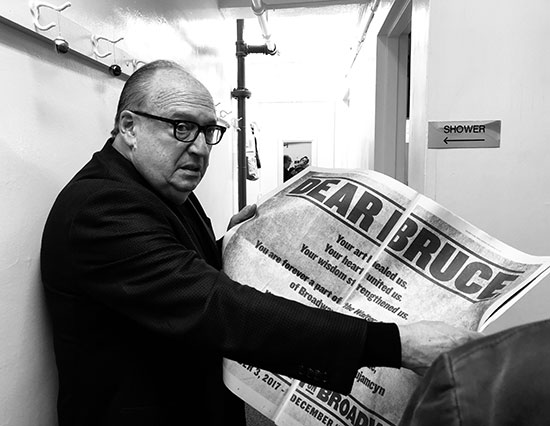
Landau in 2018, celebrating the final performance — or so we all thought — of Springsteen on Broadway
CP: As Bruce tells it, "a friend" convinced him.
JL: It wasn't me! I know exactly who it is, and when Bruce gets around to mentioning who it is, then everybody will know.
CP: It sounds like there wasn't a lot of debate. But were there pros and cons to weigh? Did you have any concerns about doing it?
JL: No, I didn't.
CP: One thing that occurred to me — it's hard to think of many times in Bruce's career when he's done something that could be perceived to be stepping backward. Redoing something. It's always been about forward movement, forward movement…
JL: You mean, like when he did the [2016] River Tour? Or, when he does classic albums from beginning to end?
CL: [Laughs] Well, okay… those felt different. And clearly, this has proven to be a different thing, too. But in terms of perception, or overall strategy, I wonder how much you have to think about that kind of thing.
JL: I did not doubt that Bruce would make changes. I just assumed that Bruce would be elevating and refining the show in some way.
Bruce loves the beach. He loves the summer. It would have been easy to take the summer off. But this idea cropped up; he thought about it briefly and said, "Yeah, I can do something a little different with it" — and that's exactly what he's doing. The new shows are incredibly well done and emotionally satisfying. I think it's an even more spiritual experience than last time. To me, it's Bruce at the top of his game. Bruce himself, the way he sings, the way he speaks, the way he put this together — the man is at the top of his game.
CP: Given that, do you think about documenting this moment, the way you did with the first run?
JL: We do want to do something. We're not going to do another film; I don't think that feels right. But, we will capture the essence of this show in a more modest style.
CP: I'd like to talk more about how quickly you were able to mount the show. Bruce says yes — then what happens?
JL: First of all, the Walter Kerr was not available — and we're still in the month of May here, May 25, something like that. So we went to look at an alternative, which was the St. James. We stepped onto the stage, and that was that. It was perfect. We loved the feel of it. I mean, literally, it was ten seconds.
Once having decided on it, we went about recreating the stage, lighting, and sound that worked so well for us at the Walter Kerr. When you see the show now, it looks just like the Walter Kerr stage.
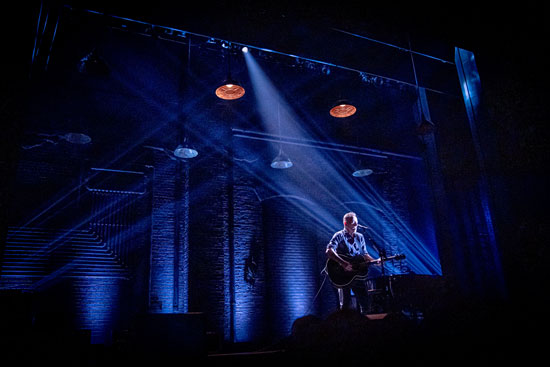
June 2021, St. James Theatre - photograph by Rob DeMartin
CP: Is there any difference you feel in going from 900 to 1,700? For better or worse? Do you lose or gain anything by having the show in a larger venue?
JL: You know, I roamed around [the St. James] during rehearsals, viewing from different positions, and it's remarkably similar, considering the increased numbers. One of the reasons is that the mezzanine is quite far forward — the whole mezzanine is slightly closer to the stage than at the Walter Kerr. So the audience is larger, but it's pretty compact in terms of front-to-back space.
When we were initially looking to do the show, we looked at many theaters — we were complete novices at that point — and we circled around the number one thousand. A thousand seats seemed to be what felt right. When we were doing the first run, Bruce's big concern was that the show requires silence. And he thought it would be easier to achieve that with around a thousand seats. After 236 shows, he's no longer worried about that. He knows that the audience understands that need for quiet, and they're usually completely with him.
This show needs to be done in a Broadway-style theater. We love the Beacon (which, no question, is much bigger), but it's a rock house: people come, they watch the show, and they get up after a while. Maybe they go to the bar; the lobby is sometimes crowded. It's a different ambiance. We really didn't think about doing it there or in any other type of venue because Broadway invites focused participation on the part of the audience. Nobody comes into a Broadway show and starts talking with the people sitting next to them. The etiquette on Broadway is traditional. And that works for this particular show.
CP: Given the schedules for both the St. James and the Walter Kerr, it looks like the extensions you added last time won't be possible for this run.
JL: We lose the theater after Labor Day, so to continue, to go to a third theater, and do the necessary prep — nobody's thinking that way.
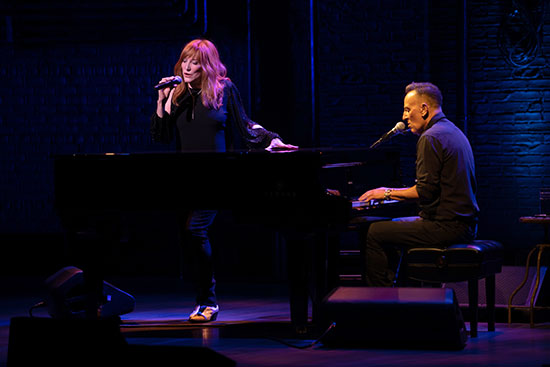
June 2021, St. James Theatre - photograph by Rob DeMartin
CP: How much were you involved in the revision and rehearsal, working up the current version of the show? Were you the eyes and ears once it was ready? Or did you and Bruce have conversations along the way?
JL: I was involved here and there, but the show is pure Bruce.
The song ideas, two of them Bruce and I talked about: "41 Shots" and "I'll See You in My Dreams." But we were just thinking the same thing. It was automatic. Those two were pretty easy to decide on.
The surprise to me was "Fire." It's a great vehicle for Patti [Scialfa]. She sings one of the verses entirely by herself, and the song is structured as a genuine duet. Patti is very liberated in her performance of the song. Her personality just shines through. It's a great "singing" song for both of them, it's great fun, and the audience responds terrifically to it.
Here's the interesting thing about Bruce and stagecraft. He goes from "Fire," which is, let's say, the lightest song of the show — the most fun and playful — and he makes a hard turn to the darkest moment of the show: "41 Shots." In "41 Shots," his face is drenched in red light that symbolizes blood. Now, to make that turn is a real feat. It's the equivalent of a shock cut in film: one second, you're over here, laughing and smiling at "Fire," and the next, you're down in the streets with "41 Shots." But it's done so well that it feels totally right and totally natural.
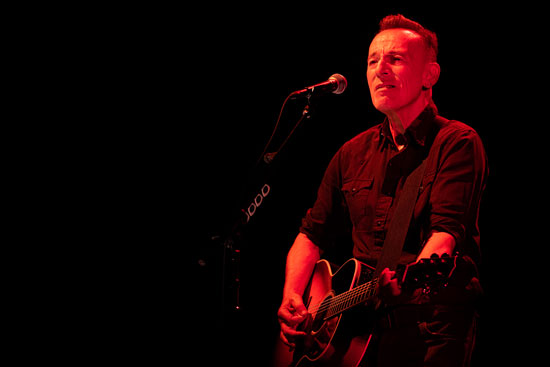
June 2021, St. James Theatre - photograph by Rob DeMartin
CP: "I'll See You in My Dreams" and "41 Shots" are major choices in terms of the story the show tells.
JL: Yes, and those changes go to a larger point, which is that three things happened since the last show. One was COVID-19, the pandemic. One was Black Lives Matter. And one was January 6.
Everybody who comes to this show, including, and especially, Bruce, has had strong feelings about these things. And I think that Bruce found a way, not just through some simple song selection, to register the fact that we have all been changed. The audience has been changed. Bruce has been changed. Everybody has spent 15 months living with a threat that had never existed before. And at times, the worst times, it was terrifying. People had to think about COVID-19 every day, and they had to think about the possible death of loved ones, themselves, friends… and so many people experienced a death in the family, or in their circle, it's been a tremendous crisis. And what Bruce brings to the show is his own experience with and feelings about it.
Obviously, "41 Shots" is a direct commentary on the rise of Black Lives Matter and his positive feelings about that; "I'll See You in My Dreams" is specifically a song about death. And dying. And affirmation. The last words of the show are: "This is not the end.… I'll see you in my dreams." That's the statement.
CP: Was it a difficult decision to cut "Born to Run"?
JL: I had a funny exchange with Bruce about this, because we had discussed it, and we were both thinking the same thing in terms of closing with "I'll See You in My Dreams."
The original show did not have an encore. Bruce didn't leave the stage; there was no encore structure to it: the audience applauds… the artist comes back in response… encore. I thought, well, maybe we'll do that here. Because "Born to Run" is "Born to Run," this time we could structure it as an encore: we could end with "I'll See You in My Dreams," and in a more typical fashion, Bruce would then go off and come back and do "Born to Run" as an encore.
And he said to me, "No." He said, " 'I'll See You in My Dreams,' that's the end of the story. That's the end of the story that I'm telling this time." And when you see the show, you will see that he was so right. So he set aside "Born to Run" altogether.
CP: Which, alone, is really something — it would be a testament to any song, that it can take the place of "Born to Run" and the show still works. I also recall it's the song that you had such an emotional reaction to in the Letter to You film.
JL: "I'll See You in My Dreams," in my view, is one of his greatest songs, and the way in which it's used in this show is spectacular.
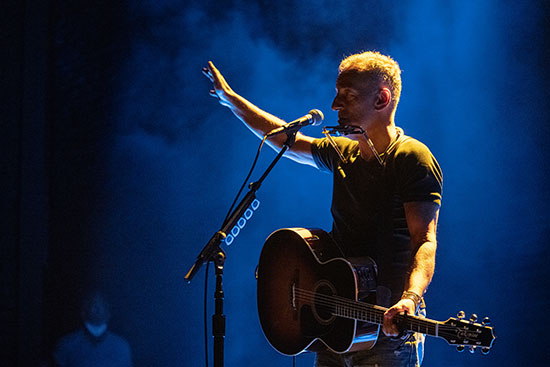
June 2021, St. James Theatre - photograph by Rob DeMartin
CP: Much like The Rising was the first real artistic statement about 9/11, this is one of the first communal experiences people are having, at least in our world, coming out of the lockdown. What's remarkable is how much the show now speaks to what we've been through — that Bruce was able to edit, revise, swap a few things, and all of a sudden, we've got something that speaks to this moment.
JL: At the beginning, he talks about the significance of us all being in a room together, in a room with 1,700 people. Until recently, when was anybody in the room with 1,700 people in the last 15 months? He acknowledges that something is different immediately.
To me, this is a significant difference in the structure of the show. The original version had a formality to it. I think this show retains some of that, but overall it is more informal than the last. I think it's a little more directly just Bruce.
CP: He's even made a running gag out of something else that happened in the last year — the "Incident at Sandy Hook" [Gateway National Recreation Area]!
JL: That was such an asinine and entirely bogus and fake controversy. It went so far beyond making a mountain out of a molehill. I'm glad he can laugh at the knuckleheads who created the situation and the media who played along (New York Times, front page? Wow, that was so wrong!).
So there are very clear differences between the two shows. You can look at setlists and say, well, only three songs changed… but much more changed. There's a different type of emotion. For me, I would say, simply, two things: It's more emotional. And that word I used before is very relevant: spiritual. It's more emotional, and it's more spiritual.
CP: Is there any advice you would give to someone who called you up and said, we're thinking about doing this? What would you have done differently? Or what would you tell them not to do?
JL: We really just followed our own game plan. We had a great partner in Jordan [Roth], who helped us with the ins and outs of Broadway theaters and local unions, workers who contributed to the show and really made that part of it go that much more smoothly. But I can't really say that there's anything I can think of that I would do differently.
CP: You've just got to be as good as Bruce Springsteen.
JL: Well, yeah! [Laughs] Look, at the end of the day, it's the guy on the stage, or the woman on the stage, and the audience. And does it happen? Does the event happen? It's like Bruce says, six o'clock, you're looking at four walls and empty seats. Those are the blank white pages of the book of life that he refers to in the show. And at eight o'clock, people are seated, and then it's up to all the people there — the artist and the audience — to create something that everybody will remember. That's his magic trick, creating that "us." For those two hours and 30 minutes, I think we ran last night… there is an "us."
I know how tough Bruce's core audience is. It's very astute and sets very high standards. It's quite demanding. But I'd be very hard pressed to see any true fan walk away from this without being deeply affected. I don't care how tough-minded you are. You can't argue with this show!
|






